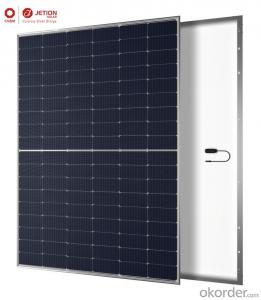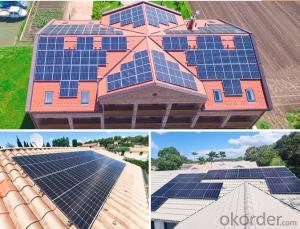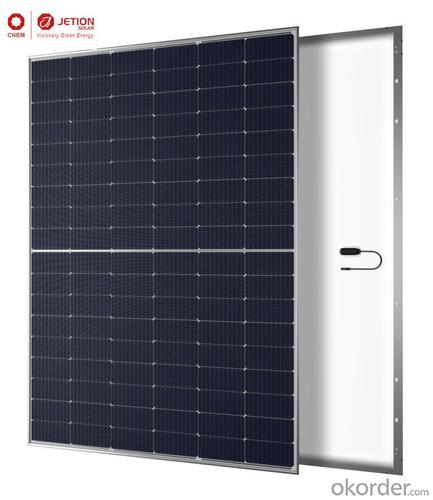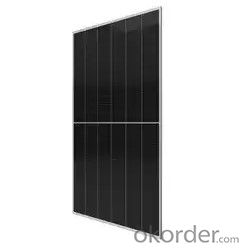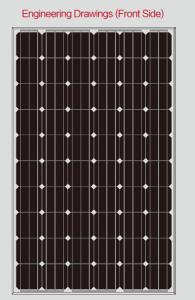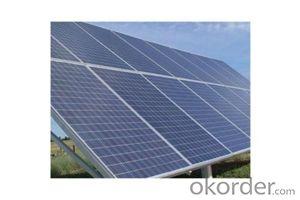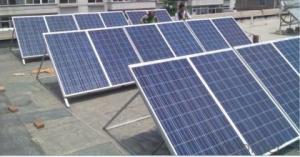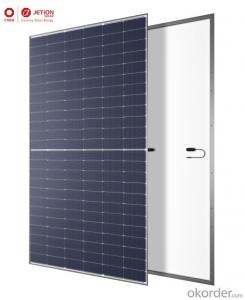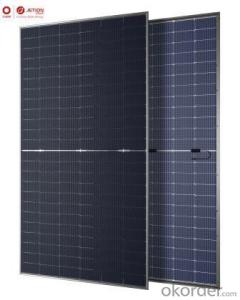Ku Solar Panels - Black Solar Panel 395-415W Faster Charging Solar Panel Kit NCQ
- Loading Port:
- SHANGHAI
- Payment Terms:
- TT OR LC
- Min Order Qty:
- 5 pc
- Supply Capability:
- 100 pc/month
OKorder Service Pledge
OKorder Financial Service
You Might Also Like
Specification
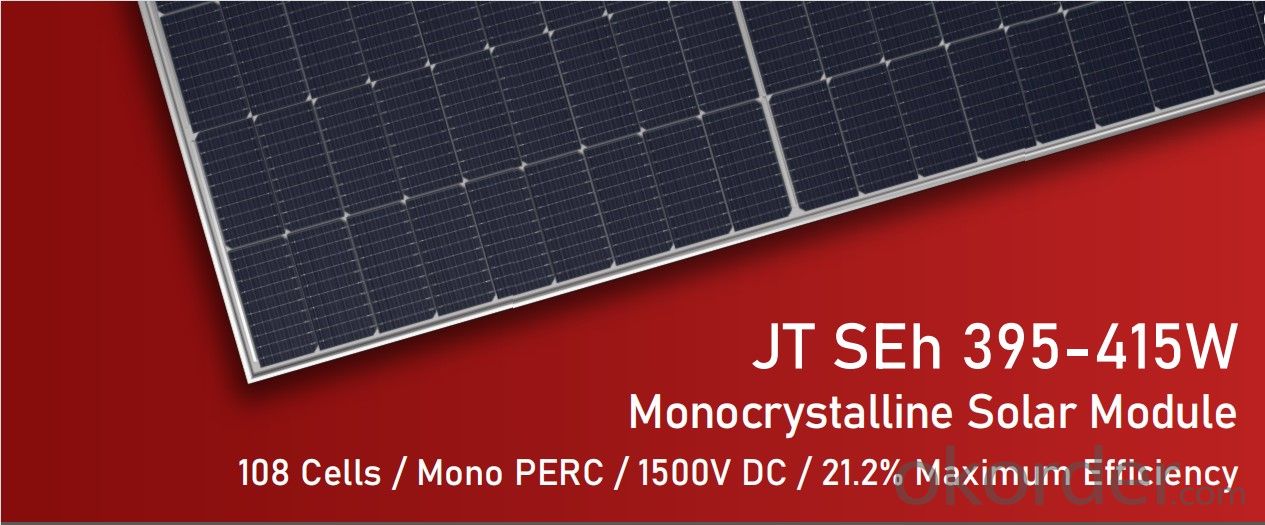
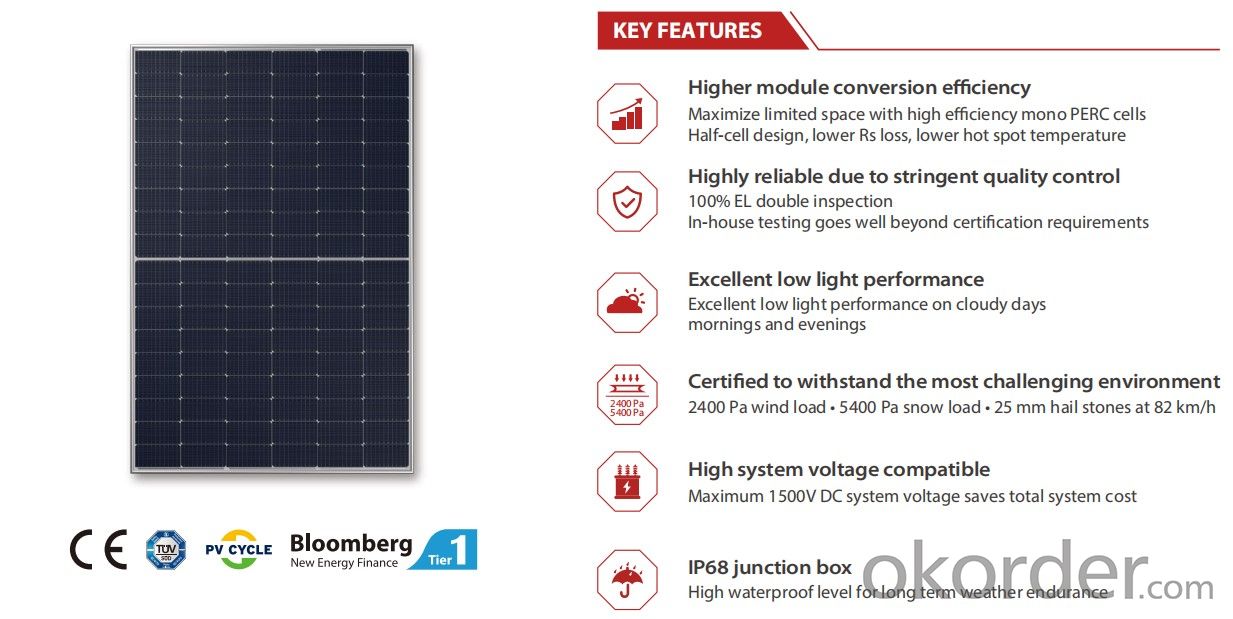
ELECTRICAL DATA*STC
TYPE(Tolerance:0-+5W) | JT395 SEh | JT400 SEh | JT405 SEh | JT410 SEh | JT415 SEh |
Maximum Power Pmax (W) | 395 | 400 | 405 | 410 | 415 |
Maximum Power Voltage Vmp (V) | 30.7 | 30.9 | 31.1 | 31.3 | 31.5 |
Maximum Power Current Imp (A | 12.87 | 12.95 | 13.03 | 13.10 | 13.18 |
Open Circuit Voltage Voc (V) | 36.8 | 37.0 | 37.2 | 37.4 | 37.6 |
Short Circuit Current Isc (A) | 13.72 | 13.80 | 13.88 | 13.95 | 14.03 |
Module Effciency (%) | 20.2% | 20.4% | 20.7% | 21.0% | 21.2% |
STC: Irradiance 1000W/m², Cell Temperature 25°C, Air Mass AM1.5
Measuring tolerance: :±3%
ELECTRICAL DATA *NMOT
Maximum Power Pmax (W) | 298.65 | 302.47 | 306.31 | 310.17 | 314.06 |
Maximum Power Voltage Vmp (V) | 28.8 | 29.0 | 29.2 | 29.4 | 29.6 |
Maximum Power Current Imp (A | 10.37 | 10.43 | 10.49 | 10.55 | 10.61 |
Open Circuit Voltage Voc (V) | 34.5 | 34.7 | 34.9 | 35.1 | 35.3 |
Short Circuit Current Isc (A) | 11.06 | 11.12 | 11.18 | 11.24 | 11.30 |
NMOT: lrradiance at 800W/m², Ambient Temperature 20℃, Wind Speed 1m/s
MECHANICAL DATA
Solar Cell Type | Mono 91x182 mm(3.6x7.2 inches) |
Number of Cells | 108[2 x(9 x 6)] |
Module Dimensions | 1722*1134*30 mm(67.8*44.6*1.2 inches) |
Weight | 20.5 kg(45.2 lb) |
Front Cover | 3.2 mm (0.13 inches), high transmission, AR coated tempered glass |
Back Cover | White composite film |
Frame | Silver, anodized aluminium alloy |
J-Box | ≥IP68 |
Cable | 4.0 mm² solar cable, 300 mm(11.8 inches) |
Number of diodes | 3 |
QUALIFICATIONS & CERTIFICATES
v IEC 61215,IEC 61730, IEC 62941
v ISO 9001: Quality Management System
v ISO 14001: Environment Management System
v ISO 45001: Occupational Health and Safety
JETION SOLAR
As a member of CNBM - a Fortune 500 company, Jetion Solar provides various product solutions,global EPC service and financing. lts standard and high-efficiency product offerings are among the most powerful and cost-effective in the industry. Till now, Jetion Solar has cumulatively more than 10 GW module shipment and 1 GW global EPC track records.
FAQ
1.how can we guarantee quality?
Always a pre-production sample before mass production;
Always final Inspection before shipment;
2.what can you buy from us?
Inverter, Solar Panels, Solar Panels Brackets, Lithium Battery
3.why should you buy from us not from other suppliers?
CNBM is a group company with skillful technical team. With First class pre - and after - sales service. We also are agent of HUAWEI inverter, Longi Solar Jinko solar and so on. The solar products will supply you with under market price.
4.what services can we provide?
Accepted Delivery Terms: FOB,CFR,CIF,EXW,FCA;
Accepted Payment Currency:USD,EUR,HKD,CNY;
Accepted Payment Type: T/T,L/C,D/P D/A,Credit Card,PayPal,Western Union;
Language Spoken:English,Spanish,German,French,Arabic
- Q: What is the efficiency of modern solar panels?
- The efficiency of modern solar panels varies, but on average, it ranges from 15% to 20%. Some high-end panels can achieve efficiencies of up to 25%. However, it's important to note that the efficiency of solar panels is constantly improving as technology advances.
- Q: where I can find solar panel the has 4.8 volts? Like those solar walkway light or something that has 4.8 volts solar panel.Do you think I can get it from home depot?
- How Solar Cells Work by Scott Aldous Inside This Article . Introduction to How Solar Cells Work 2. Photovoltaic Cells: Converting Photons to Electrons 3. How Silicon Makes a Solar Cell 4. Anatomy of a Solar Cell 5. Energy Loss in a Solar Cell 6. Solar-powering a House 7. Solving Solar-power Issues 8. Solar-power Pros and Cons 9. Lots More Information 0. See all Physical Science articles You've probably seen calculators that have solar cells -- calculators that never need batteries, and in some cases don't even have an off button. As long as you have enough light, they seem to work forever. You may have seen larger solar panels -- on emergency road signs or call boxes, on buoys, even in parking lots to power lights. Although these larger panels aren't as common as solar powered calculators, they're out there, and not that hard to spot if you know where to look. There are solar cell arrays on satellites, where they are used to power the electrical systems. You have probably also been hearing about the solar revolution for the last 20 years -- the idea that one day we will all use free electricity from the sun. This is a seductive promise: On a bright, sunny day, the sun shines approximately ,000 watts of energy per square meter of the planet's surface, and if we could collect all of that energy we could easily power our homes and offices for free.
- Q: Can solar panels be installed on schools or educational campuses?
- Yes, solar panels can be installed on schools or educational campuses. In fact, many educational institutions are increasingly adopting solar energy systems as a sustainable and cost-effective solution for their power needs. Installing solar panels on schools not only helps reduce carbon emissions and reliance on fossil fuels, but also provides educational opportunities for students to learn about renewable energy and its benefits. It can also lower electricity bills and redirect saved funds towards educational programs.
- Q: What does it take to install the solar panel? Cable wires to power source or fuse box? Anything else?How does the cable wires stay on the solar panel?
- How does the cable wires stay on the solar panel? With wire retention clips (4 per module) that are used to wrap the wire on the underside of the module frame. The home run cables to the transition box (converts between types of wire with no electrical transformation occuring) or combiner box (joins multiple source circuits in parallel, with the positives fused for safety) are usually tied along the racking system components, and with conduit sections used as needed. Racking is another big part of the installation. Don't just make your own homemade wooden rack, as these will weather away to nothing very easily, and cause great failures. GET a professionally designed metal racking system. PV modules are EXPENSIVE. Don't let the racking system cause them to break. It also requires the inverter, if you intend it to connect to the main electric service. If using multiple inverters, you need an AC combining panelboard to join them prior to entering the main electric service. Otherwise, you need to think about how else you might be using them. If you are charging batteries, you need a charge controller.
- Q: I've run out of things to keep me entertained recently and as part of a larger project, I was curious if its possible to 'McGuyver' up a solar panel out of common materials?
- It okorder /
- Q: Can solar panels be installed on metal roofs?
- Yes, solar panels can be installed on metal roofs. In fact, metal roofs are considered to be an ideal surface for solar panel installation due to their durability and compatibility with the mounting systems used for solar panels. Metal roofs provide a sturdy and stable foundation for the panels, making the installation process easier and more secure.
- Q: Can solar panels be installed on research facilities or laboratories?
- Yes, solar panels can be installed on research facilities or laboratories. In fact, many research facilities and laboratories have started to adopt solar energy to reduce their carbon footprint and dependence on traditional energy sources. Solar panels can be installed on rooftops or open spaces adjacent to the facility, providing clean and sustainable energy to power various equipment and operations. Additionally, the installation of solar panels on research facilities can serve as a demonstration of renewable energy technologies and encourage further adoption within the scientific community.
- Q: How much energy can a solar panel generate?
- The amount of energy a solar panel can generate depends on several factors, including its size, efficiency, and the amount of sunlight it receives. On average, a typical solar panel can generate between 250 to 400 watts of power per hour. However, larger and more efficient solar panels can produce even higher amounts of energy.
- Q: I have heard a lot about solar panels and I want to know how these solar panels works and is it really possible to generate electricity using solar panels. And what is the cost of getting a solar panel installed?
- solar panels are a waste, I work for the biggest energy producer on the east coast and we are required by some really dumb laws to have many types of energy sources, fo course the only ones we make money on are coal and nuclear, solar panels we lose a ton of money on because they never make up for the cost it takes to buy them, and technology cannot bring them down because their too expensive even with a gov't subsidy bc of the products to make them. Don't waste your time with them, if you want to save money get a wood furnace
- Q: Can solar panels be damaged by hail or strong winds?
- Yes, solar panels can be damaged by hail or strong winds. Hailstones can cause cracks or fractures in the glass surface of the panels, affecting their efficiency. Additionally, strong winds can potentially dislodge or break the panels if they are not properly installed or secured.
Send your message to us
Ku Solar Panels - Black Solar Panel 395-415W Faster Charging Solar Panel Kit NCQ
- Loading Port:
- SHANGHAI
- Payment Terms:
- TT OR LC
- Min Order Qty:
- 5 pc
- Supply Capability:
- 100 pc/month
OKorder Service Pledge
OKorder Financial Service
Similar products
Hot products
Hot Searches
Related keywords
